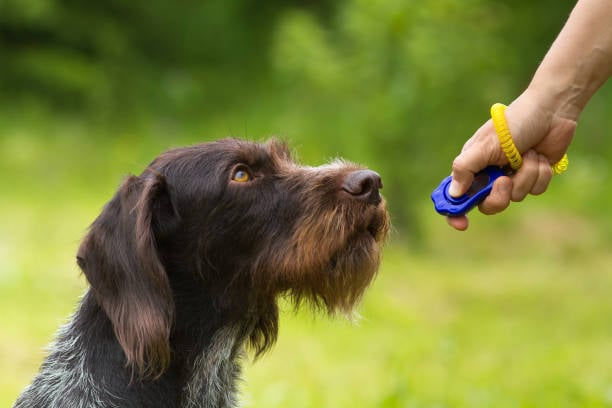With 73% of dog parents using some kind of training method with their pets, it’s clear that pet parents see the value in teaching their dogs to follow simple commands. However, understanding how dogs learn and the science behind their behavior is an essential aspect of effective dog training.
While the dog training field is incredibly diverse and complex, it largely stems from a scientific perspective. Delving into the underlying psychological principles of canine cognition and learning theories can help trainers develop effective training methods that lead to more reliable recall and better behaviors overall.
Keep reading to explore the fascinating science of dog training, from conditioning methods to how dogs learn.
4 Ways Dogs Learn
Dogs learn mostly by association. In other words, they associate a certain stimulus with a corresponding outcome, which can be either positive or negative. Keep in mind that dogs form these associations outside of training sessions, which is why trainers will sometimes need to help dogs unlearn negative or harmful associations (e.g., viewing a dog or person approaching their food bowl as a threat).

1. Classical Conditioning
Classical conditioning is the foundational principle of dog training. It is rooted in the experiments of Russian physiologist Ivan Pavlov, who famously taught dogs to associate the sound of a bell with food, eventually causing the dogs to salivate at the sound of the bell alone. This principle relies on associative learning, whereby an animal learns to connect a stimulus (such as a sound, sign, or smell) with a particular outcome.
In dog training, this might mean associating a clicker sound (conditioned stimulus) with a treat (unconditioned stimulus). Over time, the dog begins to understand that the sound of the clicker means a reward is coming, leading to the desired behavior. This mechanism is key for commands such as "sit," "stay," or "come."
When to apply this method: Use classical conditioning when you want to change a dog’s emotional response to a stimulus. For example, create a positive association with going to the vet by pairing visits with rewards.
2. Operant Conditioning
While classical conditioning connects two stimuli, operant conditioning involves a behavior and a consequence. It is through operant conditioning that dogs learn to behave in certain ways to earn rewards or avoid punishment. This principle is derived from the work of American psychologist B.F. Skinner.
One way to think about this is using the “ABC” framework, which stands for Antecedent + Behavior = Consequence. The antecedent is the thing that precedes the dog’s behavior (e.g., telling the dog to “sit”. The consequence is whatever outcome the dog experiences after expressing a certain behavior—they might get a treat or praise for following the command.
There are four quadrants of operant conditioning: positive reinforcement, negative reinforcement, positive punishment, and negative punishment.

- Positive Reinforcement: Adding something desirable (like a treat or praise) to encourage a behavior. If a dog sits on command and then receives a treat, they are likely to repeat the behavior.
- Negative Reinforcement: Removing something unpleasant to encourage behavior. For example, if a dog moves to a desired position, a trainer might stop applying pressure on a leash.
- Positive Punishment: Adding something unpleasant to discourage a behavior. For instance, scolding a dog for unwanted behavior falls under this category.
- Negative Punishment: Removing something desirable to discourage a behavior. If a dog jumps on a guest, you might take away a toy or playtime.
Dog trainers often prioritize positive reinforcement, which fosters a positive learning environment and strengthens the bond between the pet and pet parent.
When to apply this method: Leverage operant conditioning when teaching new voluntary behaviors or modifying existing ones through consequences. For example, reduce jumping by withholding attention (negative punishment), and reinforce calm behavior by giving the dog a treat (positive reinforcement).
3. Social Learning
Dogs are social animals; much of their learning comes from observing and mimicking others. This concept is known as social learning or observational learning. Dogs often learn from watching other dogs or their human companions.
For example, a puppy may learn to navigate stairs by watching an older dog. Or, if their companion is already training to sit on cue, the puppy might pick up on this just by mimicking the other dog’s behavior.
When to apply this method: Use this method when you want dogs to learn by watching others. Social learning can be especially effective in group settings (e.g., using “model dogs” in a class training environment to speed up learning).
4. Cognitive Learning
More complex forms of learning involve cognition, a field still being explored in dogs. Cognitive learning includes problem-solving abilities, understanding of object permanence, and even comprehension of human emotions and cues.
Remember that every dog is an individual, and cognitive abilities will vary. Patience, consistency, and positive reinforcement will go a long way in effective cognitive training.
When to apply this method: Use cognitive learning when teaching problem-solving skills, memory tasks, or advanced cues. This is best for mental enrichment activities, like puzzle feeders that require the dog to problem solve to access the treats.
Overcoming Challenges with Dog Learning Science
As a dog trainer, you likely encounter some of the same challenges over and over with your clients. However, applying the science-backed strategies we’ve discussed in this guide can help you overcome them. Here’s how:
Pulling on the Leash
Pulling on the leash is common for puppies and non-leash-trained dogs, but it can have consequences such as handler injuries, injuries to the dog’s neck and throat, anxiety or reactive behaviors, and other safety concerns.
Solution: Operant Conditioning
Consider using both negative punishment and positive reinforcement to correct the behavior. Any time the dog pulls at the leash, stop moving. When the dog exhibits loose leash behavior (e.g., sticking by your side rather than pulling ahead), reward them with treats or praise.
Separation Anxiety
Some dogs suffer from separation anxiety when they are left alone or are separated from their parents or families. This can be difficult to overcome, and dogs may exhibit loud barking, destructive behaviors, or extreme stress that impacts their overall health and wellness.
Solution: Desensitization & Counter-Conditioning
Pull from the core principles of classical and operant conditioning to help your furry friends overcome their anxiety. Start with very brief departures (i.e., separating the dog and their parent for a few minutes), and reward calm behavior. Gradually increase the amount of time the dog spends alone, continuing to reward calmness.
Additionally, you might pair departure cues with a high-value reward to cultivate a positive association with the parent leaving. For example, have pet parents give the dog their favorite treats when they pick up their keys or purse before leaving.
Excessive Barking
Some dogs bark at any and all stimuli, whether people passing by, the mailman delivering mail, or wildlife. However, barking can be disruptive to those in and out of the house, putting a strain on relationships with neighbors. It can also cause frustration for both the dog and the parent and, in some cases, even harm the dog’s throat.
Solution: Operant Conditioning & Desensitization
Teach the dog a verbal or visual cue for “quiet.” Each time the dog follows the cue and becomes silent, positively reinforce the behavior with a treat, pet, or praise. Then, work to expose the dog to low-level bark triggers, reinforce silence with treats, and gradually increase to high-level triggers.
For example, start with a distant car horn, then a knock at the door, and finally a high-level trigger like an unexpected loud noise or an unfamiliar guest entering the home.
Resource Guarding
Resource guarding occurs when dogs show possessive or aggressive behaviors toward items they deem valuable (e.g., food, sleeping spots, toys, etc.). While this is a natural behavior rooted in the dog’s canine instinct, it can be problematic for pet parents and other animals in the home. Dogs may exhibit subtle behaviors like stiffening or freezing, but can also escalate to more aggressive actions like growling, snarling, or biting.
Solution: Counter-Conditioning
Start with a low-value resource, such as a blanket the dog sleeps on, and work up to a high-value resource, like their favorite bone.
Identify the “safe” distance from the resource (e.g., the dog’s food bowl) that does not trigger any reactive behaviors. Approach with a higher value resource than the one the dog is currently guarding.
For example, if they are guarding their regular kibble, approach with a piece of cheese. As you get closer to the dog, immediately give them the treat so they build a positive association with someone approaching.
Poor Recall
Being able to call dogs to “heel” or “come” is crucial for keeping them safe and maintaining control in public situations. For instance, if your dog begins walking toward a busy road or another dog you aren’t sure is friendly, you can mitigate issues before they happen by calling the dog back to you. If you’re struggling to get a dog to follow this command, consider these solutions.
Solution: Operant Conditioning & Cognitive Training
Start in a low-distraction setting, such as a quiet, indoor space with no other people or animals around. Settle on a cue for the command (such as saying “come”), and have a high-value reward ready. Reinforce reliable recall with the reward, gradually increasing your distance from the dog and environmental distractions.
Additionally, you can test out social learning by having your dog watch another dog perform reliable recalls. Again, reinforce any progress the dog makes.
Wrapping Up
Understanding these fundamental learning theories can profoundly impact your dog training approach. Dog training is all about forging a deeper understanding and bond with the animal. Remember, training should always be a positive and enriching experience for you and the dog. It's an ongoing process, but with science on your side, it becomes an exciting journey of discovery.
To learn more about enhancing training outcomes or optimizing your pet-care business, explore these additional resources:
- Revolutionizing Dog Training with Modern Technology. Pair the power of science with these innovative training technologies! Learn more about the future of dog training tech in this quick guide.
- 12 Must-Try Dog Daycare Ideas for Happy, Healthy Pups. Give dogs at your daycare the best experience possible with these fun, enriching activities.
- Learn Industry Secrets with This Dog Marketing Playbook. Run a dog training or other pet-care business? Reach and engage more pet parents with this comprehensive dog marketing guide.
Subscribe to the Gingr Blog








